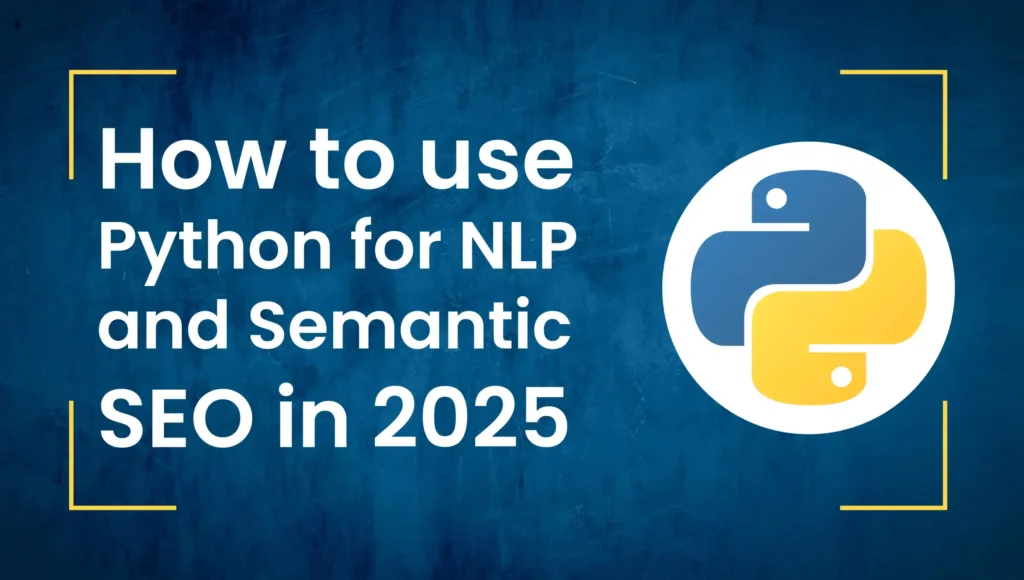Search engines no longer rely on keyword stuffing to rank pages. They focus on content that is contextually relevant and semantically meaningful. This change made Natural Language Processing (NLP) and Semantic SEO must-have tools for both marketers and developers. If you’re wondering how all of this relates to Python, you’re in for a real treat.
Due to its powerful libraries and simple-to-understand syntax, Python is a popular programming language for handling NLP, which is great for improving your SEO techniques and strategies. What if I told you that you could use Python to completely rethink your Semantic SEO strategy using NLP?
Harnessing Python for SEO tasks has transformed the way professionals approach search engine optimization. Python is a go-to tool for tasks like semantic keyword clustering and technical SEO with Python.
Using Python for Semantic SEO helps analyze keywords and optimize content with NLP. SEO for Python sites needs metadata, structured data, and server-side rendering. A Python SEO analyzer crawls websites, extracts metadata, and audits SEO. Python NLP extracts entities, clusters keywords, and improves SEO. To apply NLP in SEO, use Python to analyze search intent and group keywords. NLP enhances local SEO by extracting geo-specific queries. SpaCy in Python improves semantic search and keyword clustering. Python also groups semantic keywords with K-means or BERT. With Python NLP, you can extract Google search results semantically. In 2025, integrating Python NLP into SEO will boost rankings and user experience.
What is NLP?

Natural Language Processing (NLP) is a sub-field of artificial intelligence that is concerned with the interaction between computers and humans through natural language. You can run text data analysis on the patterns, extract meaningful information, and even analyze the sentiment of a content piece. This is important for SEO as, through NLP, websites can be optimized and content can be generated in accordance with the expectation and intent behind search engines and the user desire.
Python is a common programming language for NLP due to its ease of syntax and an abundance of libraries that make text processing much easier. NLTK (Natural Language Toolkit) and spaCy are two prominent libraries for working with NLP tasks offering different approaches.
Key Python Libraries for NLP
NLTK (Natural Language Toolkit)
NLTK is very widely used, and one of the most popular Python libraries for NLP. It offers a range of features for text preprocessing, tokenization, stemming, lemmatization, sentiment analysis, and much more. NLTK is great for beginners to get started with as it has great documentation and educational resources available.
spaCy
NLTK is good for educational purposes, spaCy is suitable for production use. It is also very fast, easy to use, and it includes pre-trained models for named entity recognition (NER), dependency parsing, and part-of-speech tagging. When performance is a concern, spaCy is the library that is most often used.
What is Semantic SEO?

The semantic web enhances search efficiency through keywords and queries, and semantic SEO focuses on optimizing content for user intent instead of keywords. This will help improve content relevance as it better understands the meaning and context behind words. As advanced NLP models like BERT (Bidirectional Encoder Representations from Transformers) was used by search engines like Google, Semantic SEO has become an integral part of obtaining higher organic rankings.
Thanks to NLP, marketers can scrutinize search queries, uncover related concepts, and organize content around user intent more holistically. Python also allows you to automate large-scale analysis and get better insights into the semantic relations between keywords and content.
What is Semantic Keyword Clustering?
Semantic keyword clustering involves grouping keywords based on their contextual and semantic relationships. This helps optimize content for related topics rather than relying solely on individual keywords. By focusing on topic-based optimization, you align your content with search algorithms, which now prioritize semantic relevance.
How NLP Enhances Semantic SEO
The following are some actionable ways to leverage Python-based NLP to power your Semantic SEO:
Keyword Intent Analysis
NLP can help you identify intent types for each keyword, for example whether it is an informational, navigational or transactional query. The queries themselves may not give away the best content to offer, but tools such as spaCy can provide an analysis of these queries, allowing you to write content in alignment with user intent.
Example:
import spacy
nlp = spacy.load(“en_core_web_sm”)
query = nlp(“Buy Python programming book”)
for token in query:
print(f”{token.text}: {token.pos_}”)
Content Gap Analysis
Python can analyze and compare your competitors’ content with yours, helping you figure out topics or keywords you’re missing. For instance, you can scrape competitor websites, and extract recurring phrases by tokenizing their content to look out for gaps.
Example: Use BeautifulSoup to scrape content and NLTK to create a word frequency distribution.
Topic Modeling
You can use topic modeling techniques like Latent Dirichlet Allocation (LDA) in Python and go to have a look at what hidden topics in your content and see if you answer to user interest.
Example: With the gensim library, you can quickly generate topic models:
from gensim import corpora, models
# Sample documents
documents = [“SEO and Python”, “Using NLP for search engines”, “Semantic SEO”]
# Tokenize and create dictionary
dictionary = corpora.Dictionary([doc.split() for doc in documents])
corpus = [dictionary.doc2bow(doc.split()) for doc in documents]
# Create LDA model
lda_model = models.LdaModel(corpus, num_topics=2, id2word=dictionary, passes=10)
print(lda_model.print_topics())
Sentiment Analysis
User engagement and satisfaction metrics are also less significant factors in search engine algorithms. The more positive wording you use on your content, the more it will push your article up. In Python, NLTK’s Vader or TextBlob can measure the tone of pages before publication.
Entity Recognition & Co-occurrence Analysis
Tools like spaCy allow you to extract entities from text, and time their co-occurrence. As you learn the keyword topics, your internal linking will become more concrete.
Example:
text = “Google and Python are popular technologies in the SEO industry.”
doc = nlp(text)
for ent in doc.ents:
print(f”{ent.text}: {ent.label_}”)
Practical Applications of Python for SEO
Product Keyword Analysis
Python can extract and analyze product-related keywords from reviews, Google Analytics, or search query data. NLP tools like spaCy or TextBlob help identify trends and preferences in customer behavior, enabling you to optimize product pages effectively.
Technical SEO with Python
Automate auditing your site for issues like broken links, crawl errors, or duplicate content. Scripts using Requests and BeautifulSoup can check HTML pages for optimization improvements, while log file analysis scripts can pinpoint technical issues affecting indexing.
Automating SEO Processes
Python allows you to automate repetitive SEO tasks. Examples include generating XML sitemaps, extracting backlink data, monitoring SERP rankings, or even auto-generating meta tags.
Case Study Example
Imagine you own a blog about digital marketing, and you want to optimize your site for the keyword query “content marketing strategies.” You can do entity extraction and find out common subtopics to be included in your articles using existing high-ranking articles with the help of Python and NLP. For example:
Grab the first few results with requests and BeautifulSoup in Python.
Use spaCy to tokenize the text and identify named entities such as social media, audience engagement and long-form content.
Use this data to create a semantically rich outline that includes these key terms and their contexts.
Optimizing your content to this caliber helps you ensure it is user-friendly and compliant with search engines.
Tips for Beginners
If you’re completely new to Python and want to use it for NLP and Semantic SEO, this is how you get started:
Learn Python Basics
You can use online resources, tutorials, and courses (such as those on Coursera and edX) to learn this, as you will need to know the syntax, data structures, and libraries (like pandas for data manipulation) in Python.
Explore NLP Libraries
Learn tokenization and sentiment analysis first, using NLTK tutorials. When you get used to working with natural language, start learning spaCy for more advanced applications.
Work with Real Data
Work with datasets from news articles, blog posts, or your own material. You can find free datasets on Kaggle.
Try out pre-trained models
Many Natural language processing tasks can be done using pre-trained models which are usually very accurate and save a lot of time. This is a good example of SpaCy’s en_core_web_sm.
Visualize Your Results
Visualize your data using libraries like Matplotlib or Seaborn. You can plot word counts, for fax, to see trends.
Final Thoughts
Python is a behemoth for Natural Language Processing and Semantic SEO. By mastering its libraries such as NLTK, spaCy, and gensim, you can automate tedious processes, gain valuable content insights, and stay ahead of the game in the fast-paced realm of SEO. Be it keyword intent analysis, search engine optimization, or voids on subjects, Python’s features make sure your strategies are productive and useful. Start small, and as you become more adept, you’ll see how much healthier your SEO game can be with Python in it. Happy coding!
FAQ
How to use NLP for SEO?
NLP (Natural Language Processing) can be used for SEO to enhance content relevance, identify search intent, and improve keyword targeting. With NLP, you can analyze your content for semantic relationships, extract keywords or entities, and detect sentiment to align with user queries. Tools like Python’s spaCy or NLTK can help automate these tasks. For example, you can use NLP to uncover related topics by analyzing user search behavior or to optimize meta descriptions and headings with the right balance of terms.
How to use Python for SEO?
Python is a powerful tool for SEO that automates mundane tasks, analyzes large datasets, and improves overall SEO strategies. Using libraries like BeautifulSoup, you can scrape website content for optimization opportunities, and with pandas, you can process analytics data more effectively. Additionally, you can use Python for tasks like generating keyword clusters, identifying gaps in content, checking backlinks, or even performing log file analysis to identify crawl errors.
What coding language is best for SEO?
While SEO doesn’t require coding, Python stands out as one of the best languages for technical SEO due to its versatility and ease of learning. JavaScript is another important language for optimizing dynamic websites and resolving render-based issues. SQL is useful for handling large datasets from analytic tools, while HTML and CSS are essential for making structural and aesthetic website improvements.
What are the 5 steps in NLP?
- Tokenization: Breaking text into words or sentences.
- Stopword Removal: Filtering out common words (like “and” or “the”) to focus on meaningful terms.
- Stemming and Lemmatization: Reducing words to their root forms (e.g., “running” becomes “run”).
- Part-of-Speech Tagging: Identifying grammatical elements in a sentence.
- NER (Named Entity Recognition): Extracting entities like people, dates, or brands from text.
These steps help in understanding and processing human language for tasks like sentiment analysis, content optimization, and more.
Does Google search use NLP?
Yes, Google search heavily uses NLP to improve search results. Algorithms like BERT (Bidirectional Encoder Representations from Transformers) process natural language queries to understand nuances like context and search intent. For example, Google uses NLP to interpret long-tail keywords, compare synonyms, and comprehend conversational queries, ensuring users get the most relevant results.


